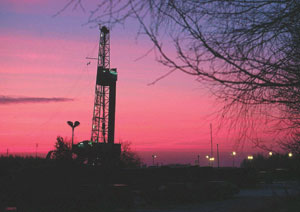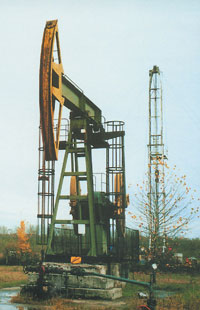FSU/ Eastern Europe: Eastern Europe
Aug. 2001 Vol. 222 No. 8 International Outlook FSU/EASTERN EUROPE Eastern Europe Romania. Significant decreases in new oil and gas wells drilled in 2000 were
FSU/EASTERN EUROPEEastern EuropeRomania. Significant decreases in new oil and gas wells drilled in 2000 were counterbalanced by increased production from old wells. New oil well production dropped 59% (to 2,800 bpd from 6,800 bpd), and new gas well production dropped almost 50% (to 8.7 MMcfgd from 17.1 MMcfgd). However, minor production increases from old oil and gas wells (1.5% and 3%, respectively) and substantial increases in oil well workovers (24%) helped keep total production from falling too far. Romanian firm Petrom’s increased focus on workovers to maintain production may generate cost-savings that can be invested in exploration and new production technologies, such as horizontal drilling, hydraulic fracturing in old wells, etc. Horizontal drilling is rare in Romania. However, Petrom in 2000 had an important success with one of the first, OB1 Bragareasa, which produced 750 bopd, equivalent to 100 older vertical wells in Romania. Petrom also made extra efforts to drill wells deeper than 10,000 ft. Such completions included 3951 Lovrin (12,103-ft TD), 101 Lovrin (12,156-ft TD) and 61 Galumbu (14,551-ft TD). Deeper offshore exploration included 7 Calypso (11,811-ft TD), 4 Opal (11,811-ft TD) and 62 Pescarus (12,546-ft TD). Hunt Oil has an interest in 3 million undeveloped acres that could yield additional oil and gas, and is exploring portions of the Black Sea on the Romanian coast. Ramco Energy is active in Moinesti Block 6, and seismic data indicate the presence of a significant Poduri prospect. In addition, cooperation between Petrom and M-I Drilling gave Petrom access to Western drilling technologies, methods and special drilling mud products. Paladin Resources, which bought Arco’s rights to the Doina 1 natural gas discovery in Block 13, completed a 900-mi, 2-D seismic program and plans to drill in 2001. Hungary. Oil and gas production is well below the demand level. In 2000, Hungary consumed 53.3 MMboe, while domestic production accounted for only 8.5 MMboe. If current oil production is maintained, the total known reserves will be gone in 15 to 20 years. And with 2.6 Tcf of known natural gas reserves – most of which are in the country’s east and southeast areas – and an annual production of about 127Bcf (which cover about 30% of demand) domestic gas supplies should last for less than 20 years. There are parts of the country that remain unexplored, so there may be undiscovered hydrocarbon resources. Analysts believe that 67 to 388 million bbl of oil and 1 to 3.3 Tcf of natural gas remain undiscovered. National oil company MOL continued to develop its domestic E&P activities in 2000. Most of MOL’s fields are mature, and production is expected to decrease by 6% to 9% annually. Nevertheless, MOL’s E&P division was able to increase profitability in 2000 by dynamic rationalization of operating costs and increased prices. Development plans are being revised in line with the availability of new technology that enables MOL to enhance recovery and thereby increase recoverable reserves. MOL conducted a 3-D survey adjacent to producing fields in traditional blocks, covering 400 sq mi and targeting smaller, previously undetectable satellite reservoirs in Algyö field. Results are now being interpreted and will form the basis for drilling operations in the coming years. Additional proven reserves of about 35 MMboe have been registered, mainly in the Mezösas-West field. Furthermore, MOL made a small crude discovery in Szentmihálytelek, in a satellite structure in the vicinity of an existing field. Seismic surveys are planned for the Trans-Danube mountain, Sárköz and Danube basin areas. Drilling was only about half of 1999’s level, at 17 wells and 109,021 ft. MOL forecasts a recovery to 20 wells. Liquids output dipped 1%, to 32,049 bpd. Gas production fell 6.3%, to 307.7 MMcfgd. Poland. In 2001, the Ministry of Environmental Protection is tendering five blocks in central Poland for exploration / drilling. Meanwhile, efforts to accelerate privatization of Poland’s oil and gas industry may be the result of declining activity in 2000. Total wells declined nearly 30%, to 56 from 76, with a comparable 26% decline in total footage drilled. Exploration activities increased, however, with an almost 30% jump in 2-D and a 34% jump in 3-D seismic surveys. EuroGas, Inc., received 10 concessions to explore and develop 1,670 sq mi in southeastern Poland. The Polish Oil and Gas company and Academy of Mining identified 12 prospects near Sanok, the largest of which is about 6,500 ft deep and may hold 350 million boe.
Assuming a continuation of high oil prices and increased revenues, Polish operators will boost 2001’s drilling back to 1999’s levels. Thanks to workovers and new completions, onshore oil output nearly doubled, to 7,241 bpd. Offshore crude production rose to 7,270 bpd. Montenegro. Ramco operates the Ulcinj Block, in the southern part of Montenegro’s continental shelf together with an adjacent strip along the coast. Seismic data and extensive geological studies are expected to lead to drilling in 2001. Several oil companies are reviewing the data with an eye for further exploration and development. Croatia. Oil production continues to remain lower than pre-1991 levels, with output estimated at 22,960 bpd (down 6.5%) in 2000. Croatia’s oil consumption in 2000 was estimated at 85,000 bpd. Drilling totaled 30 wells and 114,740 ft, up 329% and 417%, respectively. State company INA expects about 20 wells this year. Croatia has estimated natural gas reserves of 1.2 Tcf, with considerable reserves located in the Adriatic Sea. Croatia’s 17 gas fields last year produced 158 MMcfgd. With natural gas consumption predicted to increase as the country’s economy recovers, Croatia continues to explore for and develop natural gas with foreign partner Eni/Agip in the Ivana area of the northern Adriatic Sea. In September 2000, the "Ivana B" gas production platform was installed on a jacket located 27 mi southwest of Pula. The platform’s life expectancy is 20 years. Drilling at Ivana totaled nine wells last year, all gas completions.
INA invested $154 million to exploit four gas fields that have total proven gas reserves of about 282 Bcf. However, total output at the fields is expected to eventually reach 388 Bcf, of which INA will receive 247 Bcf. There are also thought to be extensive reserves in the central and southern Adriatic. Czech Republic. In June 2000, Canada’s Geocan Energy acquired the 58-sq-mi Rostin Block, 137 mi southeast of Prague. The firm subsequently acquired the Breclav (11 sq mi) and Bucovice (19 sq mi) Blocks in July 2000 and January 2001, respectively. The blocks are four-year permits, with no drilling commitments. Drilling and exploration increased in 2000, with 20% more wells drilled and 34% more area covered by 3-D seismic surveys (to 25 sq mi). Total drilling footage jumped 57% (to 98,475 ft), but production slumped in both oil (down 4.5%) and natural gas (down 12.5%). Additional increases in exploration and drilling are planned for 2001. State firm Moravske naftove doly (MND) estimates 18 to 20 wells will be drilled, and 50 mi of 2-D and 44 sq mi of 3-D seismic surveys will be conducted. Slovakia. The Slovak Republic has minor oil resources, relying on oil imports from the Russian Federation (through the Druzba pipeline) to meet approximately 97% of its oil needs. Oil reserves are 70 million bbl, while oil production averages just over 1,000 bpd. Drilling fell 12% last year, to seven wells and 24,112 ft. State firm Nafta a.s.Gbely produced 888 bopd (down 2%) from 108 oil wells (105 on artificial lift) and 20 MMcfgd (down 5%) from 46 active gas wells. A drilling total of eight wells and 200 bcpd is predicted by Nafta a.s. Gbely for 2001. Meanwhile, the state company is conducting a new reservoir evaluation of Trebisov gas field in the East Slovakian basin on behalf of joint venture partner EuroGas, Inc. The six wells drilled at Trebisov will require fracturing to be commercially producible. Albania. Three exploration licenses for three onshore blocks became effective at mid-year. Geophysical exploration began late in the year with OMV as operator (51%) and Hellenic Petroleum as partner (49%). In other developments, Lundin Oil withdrew from Block 2, where in November, Shpiragu-1 was spudded and drilled to about 14,764 ft, only to come up dry. Lundin Albania Ltd. maintains a 20% interest in another block in Albania. Albanian drilling declined to one well and 5,250 ft, down from two wells and 10,500 ft in 1999. A mild rebound to four wells is forecast by state firm Albpetrol for 2001. Oil production averaged 8% higher, at 5,664 bpd. Gas output was 19% lower, at 1.11 MMcfd. Crude reserves were off 1%, at 35.7 million bbl. Natural gas reserves were nearly unchanged at the end of 2000, at 141Bcf. Bulgaria. Relaxed regulations and lower taxes have fueled increased interest in exploration. In June 2000, Bulgaria’s Ministry of Environment and Water opened a 1,004-sq-mi area block in the central part of the Black Sea shelf, and a block near the Rezovska River and Turkish border. In May 2001, Ramco Energy plc (Ramco), signed an agreement with Anschutz Bulgaria Ltd. to explore the A-Lovech license area in northwestern Bulgaria. Anschutz was originally awarded the block in April 2000 and will act as operator for the area. The agreement gives Ramco a 20% interest, and Anschutz retains 80% interest of the license area, which is 50 mi northeast of Sofia. Minimum work obligations for the license area include two years of geological work and the reprocessing of existing seismic data before April 11, 2002, followed by acquisition of 100 km of new seismic data in the following year. A-Lovech covers 1,830 sq mi and is located south of the oil and gas fields operated by the Bulgarian company, Pleven Oil & Gas. It contains Chiren gas field, now converted to gas storage. Rights to the shallow fields in the A-Lovech Block are excluded from the agreement. The acreage is a thrust belt play similar to Ramco’s Carpathian Block in southern Poland. Anschutz specializes in the exploration of, and production from, thrust belts, and has identified several deep structures at a depth of about 13,000 ft. Bulgarian drilling totaled two completions (one oil, one gas). Total footage, all onshore, was 17,209 ft. No wells are slated this year. Production from 227 oil wells and 10 gas wells averaged 851 bopd and 1.5 MMcfgd. Slovenia. Despite a 6,955-ft well drilled in 2000, Slovenia’s producing wells declined by three oil wells (to 9 from 12) and one gas well (to 11 from 12). Oil production held steady, but natural gas output declined 10%. Estimated proven oil reserves declined 1.2%, and estimated proven reserves of natural gas declined 15%. However, encouraging news comes from an agreement with
Dubai’s Nemmoco and the recent discovery of natural gas at Vuzmetinci. State firm Nafta Lendava and
Nemmoco Slovenia Corp. signed a $25-million joint venture agreement to explore and produce the oil and gas
fields at Petiöovci and Dolina pri Lendavi. Surveys indicate an estimated 3 – 5 million bbl of oil
could be extracted over the next 15 years. The project represents the beginning of the realization of Nafta
Lendava’s strategic development objectives and activities.
|




